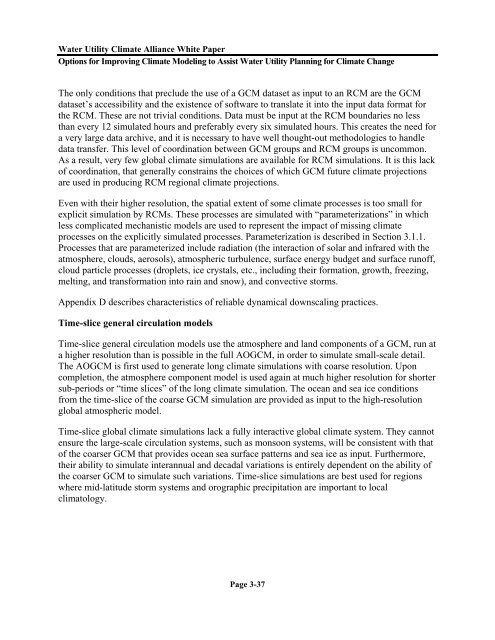Options for Improving Climate Modeling to Assist Water Utility ...
Options for Improving Climate Modeling to Assist Water Utility ...
Options for Improving Climate Modeling to Assist Water Utility ...
You also want an ePaper? Increase the reach of your titles
YUMPU automatically turns print PDFs into web optimized ePapers that Google loves.
<strong>Water</strong> <strong>Utility</strong> <strong>Climate</strong> Alliance White Paper<br />
<strong>Options</strong> <strong>for</strong> <strong>Improving</strong> <strong>Climate</strong> <strong>Modeling</strong> <strong>to</strong> <strong>Assist</strong> <strong>Water</strong> <strong>Utility</strong> Planning <strong>for</strong> <strong>Climate</strong> Change<br />
The only conditions that preclude the use of a GCM dataset as input <strong>to</strong> an RCM are the GCM<br />
dataset’s accessibility and the existence of software <strong>to</strong> translate it in<strong>to</strong> the input data <strong>for</strong>mat <strong>for</strong><br />
the RCM. These are not trivial conditions. Data must be input at the RCM boundaries no less<br />
than every 12 simulated hours and preferably every six simulated hours. This creates the need <strong>for</strong><br />
a very large data archive, and it is necessary <strong>to</strong> have well thought-out methodologies <strong>to</strong> handle<br />
data transfer. This level of coordination between GCM groups and RCM groups is uncommon.<br />
As a result, very few global climate simulations are available <strong>for</strong> RCM simulations. It is this lack<br />
of coordination, that generally constrains the choices of which GCM future climate projections<br />
are used in producing RCM regional climate projections.<br />
Even with their higher resolution, the spatial extent of some climate processes is <strong>to</strong>o small <strong>for</strong><br />
explicit simulation by RCMs. These processes are simulated with “parameterizations” in which<br />
less complicated mechanistic models are used <strong>to</strong> represent the impact of missing climate<br />
processes on the explicitly simulated processes. Parameterization is described in Section 3.1.1.<br />
Processes that are parameterized include radiation (the interaction of solar and infrared with the<br />
atmosphere, clouds, aerosols), atmospheric turbulence, surface energy budget and surface runoff,<br />
cloud particle processes (droplets, ice crystals, etc., including their <strong>for</strong>mation, growth, freezing,<br />
melting, and trans<strong>for</strong>mation in<strong>to</strong> rain and snow), and convective s<strong>to</strong>rms.<br />
Appendix D describes characteristics of reliable dynamical downscaling practices.<br />
Time-slice general circulation models<br />
Time-slice general circulation models use the atmosphere and land components of a GCM, run at<br />
a higher resolution than is possible in the full AOGCM, in order <strong>to</strong> simulate small-scale detail.<br />
The AOGCM is first used <strong>to</strong> generate long climate simulations with coarse resolution. Upon<br />
completion, the atmosphere component model is used again at much higher resolution <strong>for</strong> shorter<br />
sub-periods or “time slices” of the long climate simulation. The ocean and sea ice conditions<br />
from the time-slice of the coarse GCM simulation are provided as input <strong>to</strong> the high-resolution<br />
global atmospheric model.<br />
Time-slice global climate simulations lack a fully interactive global climate system. They cannot<br />
ensure the large-scale circulation systems, such as monsoon systems, will be consistent with that<br />
of the coarser GCM that provides ocean sea surface patterns and sea ice as input. Furthermore,<br />
their ability <strong>to</strong> simulate interannual and decadal variations is entirely dependent on the ability of<br />
the coarser GCM <strong>to</strong> simulate such variations. Time-slice simulations are best used <strong>for</strong> regions<br />
where mid-latitude s<strong>to</strong>rm systems and orographic precipitation are important <strong>to</strong> local<br />
clima<strong>to</strong>logy.<br />
Page 3-37

















